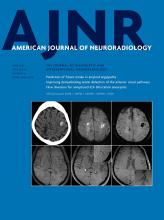The use of rapid MRI techniques to avoid CT in patients with indwelling shunt catheters is a well-known means of reducing radiation exposure to a vulnerable population. Fast MRIs of the brain avoid the risks related to sedation, can be accomplished quickly, and provide a sensitive means to assess ventricular size. In 2012, Koral et al1 estimated that the use of fast MRI of the brain instead of standard CT could prevent 1 excess fatal cancer per 97 pediatric patients.
Ordering providers and radiology departments may fail to promote the use of this technique for patients requiring emergent shunt evaluation despite this benefit, as CT is simply faster and more convenient. At the institution described by Koral et al,1 86% of the 679 fast brain MRIs ordered for ventricular size evaluation in 2016 were performed on an outpatient basis, while only 3% were ordered by the emergency department, and 22 patients received at least 5 head CTs for shunt evaluation during the year. During the same year, the emergency department requested 71% of the 502 head CTs performed for shunt evaluation, even though 90% of the CTs were ordered during a shift when an MRI technologist was available on site. This means that the cancer-reducing benefit of the fast brain MRI was rarely realized by patients presenting to the emergency department with a need for shunt evaluation.
While it is unlikely that fast MRIs for ventricle evaluation will replace CT entirely, radiologists should ensure that providers are aware of the utility of rapid MRI techniques and encourage workflow strategies that allow for fast MRI to be performed emergently, especially because these patients are often subject to multiple imaging examinations to evaluate these devices. This may serve as an opportunity to create MRI volume overnight, which can justify staffing of MRI personnel during an era in which hospitals are increasingly demanding extended coverage for radiology services. If the fast MRI is the most appropriate test for a patient, and the patient needs the examination emergently, then it seems reasonable to ensure that the patient has access to that examination.
Reference
- 1.↵
- © 2021 by American Journal of Neuroradiology












